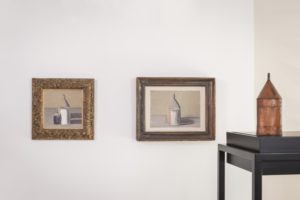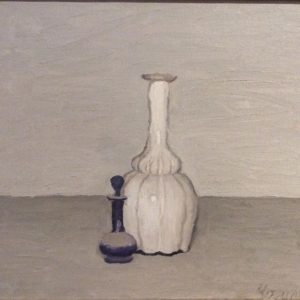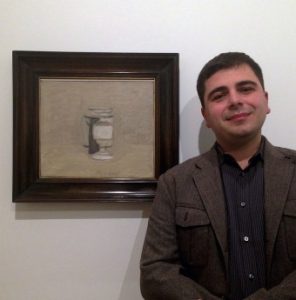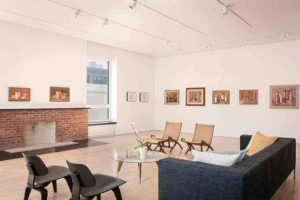 On Saturday afternoon I went directly from Penn Station to New York’s Center for Italian Modern Art to see an exhibition of some forty-odd paintings and works on paper by Giorgio Morandi. His work has long had special meaning for me, so much so that I once went so far as to bid—unsuccessfully, alas—on a Morandi etching at Sotheby’s, an experience for which the only possible word is…well, chastening. (Exhilarating, too, but I would have gladly traded the excitement for the etching.)
On Saturday afternoon I went directly from Penn Station to New York’s Center for Italian Modern Art to see an exhibition of some forty-odd paintings and works on paper by Giorgio Morandi. His work has long had special meaning for me, so much so that I once went so far as to bid—unsuccessfully, alas—on a Morandi etching at Sotheby’s, an experience for which the only possible word is…well, chastening. (Exhilarating, too, but I would have gladly traded the excitement for the etching.)
I wrote a Washington Post column about a gallery show of Morandi’s paintings back in 2004. I still feel the same way about them:
The effect of this show is wildly disproportionate to its minuscule size: six oil paintings and two works on paper, all of them still lifes and none in any obvious way imposing. Yet as you look at how the greatest Italian artist of the twentieth century century painstakingly arranged and rearranged a dozen bottles, bowls and boxes on a table and painted them over and over again, you find yourself whisked out of the grinding noise of everyday urban life and spirited away to a place of intense stillness. It’s as if a soft-spoken man had slipped discreetly into a small room open to the public, whispering life-changing confidences to the fortunate few who visit him there.
What gives Morandi’s paintings their near-inscrutable power? It’s partly the brushwork, at once delicate and forthright, and partly the extreme subtlety with which he varied his narrow palette of colors. I’m no less fascinated by the way in which he pushes himself to the edge of abstraction in so many of his later works. Those homely objects (some of them easily recognizable from canvas to canvas) grow increasingly vaporous, even transparent…
Though coveted by connoisseurs, Morandi’s tabletop microcosms have never been popular in this country, or anywhere else. None of them is currently hanging in a New York museum (though two exquisite etchings just went on the block at Sotheby’s), nor has Morandi ever been the subject of a full-scale American retrospective. Until last month, Washington was the only city on this side of the Atlantic where you could occasionally see more than one of his paintings at a time: three at the Hirshhorn, two at the Phillips. In addition, several regional museums own individual Morandis—there’s one in Princeton, N.J., for instance, and another in St. Louis—but if you want to see his work in bulk, you pretty much have to go to the Museo Morandi in Bologna, Italy, from which three paintings in this show are on loan.
 Four years later the Metropolitan Museum of Art finally mounted a large-scale retrospective, to which I went twice. But the very idea of a blockbuster show devoted to an artist like Morandi, as I wrote at the time, was a contradiction in terms:
Four years later the Metropolitan Museum of Art finally mounted a large-scale retrospective, to which I went twice. But the very idea of a blockbuster show devoted to an artist like Morandi, as I wrote at the time, was a contradiction in terms:
The curators of the show made the inexplicable and irreparable mistake of installing it in a high-traffic area that is mere steps away from the museum’s new downstairs cafeteria. As a result, “Giorgio Morandi, 1890-1964” is drawing large numbers of people who would rather talk than look at art, not a few of whom seem unaware that the use of a cellphone within five hundred yards of a Morandi still life would be punishable by death and/or dismemberment if I had anything to do with it….
Morandi is a difficult painter, one whose still lifes inevitably strike the casual viewer as both repetitive and plain. They require close, quiet attention in order to be appreciated. Giorgio Morandi: The Art of Silence is the apt title of a monograph about Morandi published a couple of years ago. It is inconceivable that anyone capable of talking in the presence of Morandi’s late watercolors, which are so concentrated and oblique as to border on outright abstraction, could possibly be appreciating them.
 Not so the show at the Center for Italian Modern Art. While it is, to be sure, comparatively large—this is only the third time in my life that I’ve seen more than a half-dozen Morandis in one place—CIMA is presenting the paintings in a way infinitely better suited to their intimate essence. In order to see them, you must make an appointment to tour the center, which is located in lower Manhattan. When you arrive, you first sit down in the kitchen with your fellow visitors and drink an excellent cup of espresso made by the staff. Then one of CIMA’s resident scholars (ours was Nicola Lucchi) walks you through the show, talking very intelligently about the artist and his work. Once the tour is finished, you’re free to wander at will through the three rooms where the paintings are hung. These rooms are all furnished in such a way as to suggest a private home, with plenty of couches and chairs on which you can sit, look, and reflect for as long as you like.
Not so the show at the Center for Italian Modern Art. While it is, to be sure, comparatively large—this is only the third time in my life that I’ve seen more than a half-dozen Morandis in one place—CIMA is presenting the paintings in a way infinitely better suited to their intimate essence. In order to see them, you must make an appointment to tour the center, which is located in lower Manhattan. When you arrive, you first sit down in the kitchen with your fellow visitors and drink an excellent cup of espresso made by the staff. Then one of CIMA’s resident scholars (ours was Nicola Lucchi) walks you through the show, talking very intelligently about the artist and his work. Once the tour is finished, you’re free to wander at will through the three rooms where the paintings are hung. These rooms are all furnished in such a way as to suggest a private home, with plenty of couches and chairs on which you can sit, look, and reflect for as long as you like.
 Having collected art for more than a decade, I know what a priceless privilege it is to be able to look at paintings in a domestic setting. But if, in addition, you must make your home in a noisy city like New York, then it is not merely a privilege but a necessity to retreat at regular intervals from the hum and buzz of urban life and commune with the work of an artist who, like Morandi, has the power to fill the soul with silence. In the absence of such silences—and such art—there can be no thought, no imagination, no respite from the unceasing flow of words, most of them pointless, that blunts our capacity to think and feel.
Having collected art for more than a decade, I know what a priceless privilege it is to be able to look at paintings in a domestic setting. But if, in addition, you must make your home in a noisy city like New York, then it is not merely a privilege but a necessity to retreat at regular intervals from the hum and buzz of urban life and commune with the work of an artist who, like Morandi, has the power to fill the soul with silence. In the absence of such silences—and such art—there can be no thought, no imagination, no respite from the unceasing flow of words, most of them pointless, that blunts our capacity to think and feel.
Josef Pieper said it: “Unless we regain the art of silence and insight, the ability for non-activity, unless we substitute true leisure for our hectic amusements, we will destroy our culture—and ourselves.” Blessings, then, on CIMA for creating a refuge in the midst of clamor to which the exhausted urbanite can withdraw to look, contemplate, and love.
* * *
“Giorgio Morandi” is on view through June 25 at the Center for Italian Modern Art, located at 421 Broome Street in New York. For more information, go here.
To purchase the catalogue, go here.
